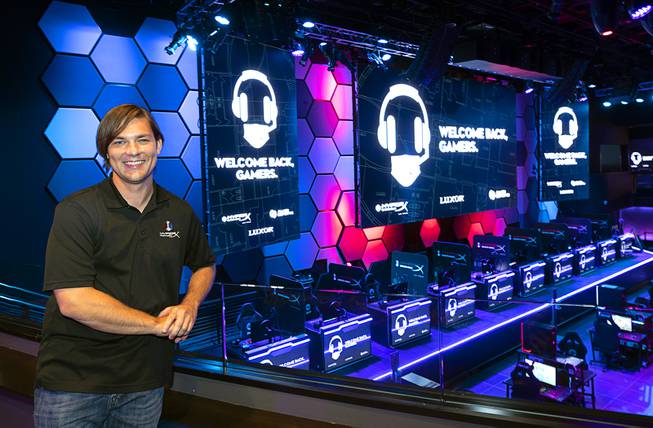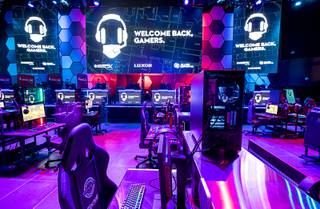
Ryan Polidan, marketing analyst at the HyperX Esports Arena, poses in a Boss Level Suite prior to the reopening at the Luxor Thursday, June 25, 2020. The front lobby is open daily for gaming. The main arena is open for tournaments on Wednesday, Friday and Saturday.
Thursday, July 2, 2020 | 2 a.m.
Ryan Polidan fidgets in his leather chair positioned toward the front of the Boss Level Suite overlooking the playing floor at the HyperX Esports Arena inside the Luxor.
The arena’s marketing analyst and industry expert is describing the way he’s seen interest in esports and video games skyrocket over the past few months—and considering ways the partially reopened venue can capitalize on the increased exposure.
“Very rarely have I turned on ESPN or TNT and seen esports. If at all, it would be like Friday night at 10 p.m., one of the worst spots traditionally,” Polidan says. “But now I’m seeing esports all the time. One of the ESPN sub-channels was running it all day and during prime-time hours. It’s so cool.”
Esports is one of few industries to thrive during the pandemic, and Polidan has seen it firsthand. HyperX shut down with the rest of the Strip in March before relaunching June 2. But Allied Esports, which owns the arena, didn’t totally shutter operations. It continued running Twitch-streamed online tournaments throughout quarantine and was rewarded with record viewership.
The same has been true for esports as a whole, with Forbes reporting a record 3.1 billion hours watched on Twitch during the first quarter of 2020.
Digital video-game sales also hit an all-time high of $10.5 billion in April, according to Nielsen SuperData. Forbes projects 495 million people will watch esports worldwide this year, meaning HyperX could become an even bigger destination than it has been during its first two years of operation in the space that formerly housed LAX Nightclub.
Allied Esports has affiliate arenas in Hamburg, Germany; Melbourne, Australia; and Orange County, California, with several more in various stages of development. But the company says it plans to keep Las Vegas its premier site.
HyperX adjusted schedule
Walk-up video gameplay: Monday-Thursday, 4-11 p.m.; Friday, 4 p.m.-midnight; Saturday, noon-midnight; Sunday, 12-11 p.m., front lobby; $15 for one hour, $25 for two hours, $40 for four hours, $50 for day pass, $125 weekend pass, locals receive double time with ID.
Tournaments: 4-11 p.m. on Wednesdays, (Super Smash Bros.), Fridays (Fortnite), and Saturdays (Mario Kart); main room; registration fees start at $10; prize pools reach $2,000.
At Luxor, 702-723-2355, hyperxesportsarenlasvegas.com.
“This is the flagship,” says Mark Green, Allied Esports vice president of properties. “The other ones are smaller. This is the mecca of esports right now. This is the blueprint moving forward, because it’s our first one. We set the benchmark. People come from all over the world to check this out.”
Visitors take in quite the production, with HyperX going all out to make an impression. Lights of all colors bounce around the 30,000-square-foot, two-story, otherwise-dark room.
Stations for hourly gameplay dot the floor, although those are momentarily disabled as a continuation of social-distancing precautions. At the moment, walk-up video game play is limited to the lobby.
The main room will be used three times a week—Wednesday, Friday and Saturday—when HyperX makes use of its 1,400-square-foot stage with live tournaments of the most prominent video games.
The players, many of whom qualify through a series of online rounds, walk through a “hype tunnel” surrounded by flashing LEDs as they’re announced—similar to the way starting lineups are made public for a hockey or basketball game.
“People think it’s weird or fear what they can’t understand, but part of our job is to close that gap,” Polidan says. “We want a spectator to come in and be on sensory overload in this place. That way, we can bridge that gap and say, ‘Here’s what’s happening. On a fundamental level, it’s just competition through video games.’ ”
Gameplay stations are equipped with 40 games, including popular titles like Call of Duty, Fortnite, League of Legends and Rocket League, with options rotated frequently to reflect current trends. When Valorant became the hottest new game during lockdown, Polidan rushed to make sure it was available on the arena servers. He’s also considering hosting future tournaments with the game, given its popularity.
For now, however, HyperX—which boasted a pre-coronavirus capacity of 1,000 people—is cutting back on bigger events. In 2018, Tyler “Ninja” Blevins, perhaps the world’s biggest esports star, streamed live from the venue, quickly selling out HyperX and setting a then-record with 2.38 million Twitch viewers throughout the six-hour session.
Long term, Green and his team envision eventually getting back to those types of spectacles.
“We’re trying to take people out of their house and bring them into this arena with like-minded people,” Green said. “We’re encouraging them to be social. A sense of community is everything to us.”
Polidan, a lifelong local who graduated from Coronado High, likens his dream for esports to what he witnessed with the Vegas Golden Knights. He says the sense of camaraderie and pride the Golden Knights brought to the area can be duplicated on a global scale with esports.
“Our long-term goal is, when you go into your local bar and you have traditional sports on a ton of TVs, in the spot right next to it you have esports, and it feels just as comfortable as everything else,” Polidan says.
This story appeared in Las Vegas Weekly.

